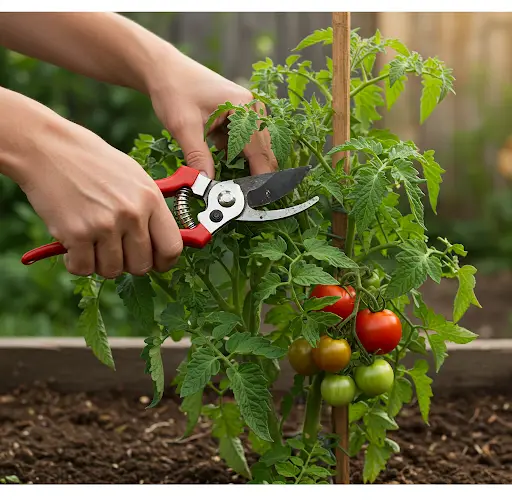When is the Right Time to Remove Leaves and Cut the Top of Tomato Plants?
Tomatoes are one of the most popular garden crops, and proper pruning techniques can significantly impact their growth, yield, and overall plant health. Knowing when and how to remove leaves and cut the top of a tomato plant ensures the best possible harvest. In this guide, we will discuss the right time and method for these essential pruning tasks to maximize fruit production and maintain plant vitality.
Why Should You Remove Leaves from Tomato Plants?
Removing excess leaves from tomato plants has several benefits, including:
- Improved Air Circulation: Pruning reduces leaf density, allowing air to flow freely, which minimizes the risk of fungal infections such as blight and powdery mildew.
- Enhanced Sunlight Exposure: With fewer leaves, more sunlight reaches the fruit, aiding in faster ripening and improving fruit quality.
- Better Energy Distribution: When unnecessary leaves are removed, the plant directs more energy toward fruit development instead of supporting excessive foliage.
- Reduced Pest Issues: Many garden pests, such as aphids and whiteflies, hide in dense foliage. Pruning makes it easier to spot and control these pests.
When and How to Remove Tomato Leaves?
Leaf removal should be done at different stages of growth based on the plant’s needs.
1. Early Growth Stage (Seedlings to Pre-Flowering)
- At this stage, avoid removing too many leaves, as young plants need them for photosynthesis and rapid growth.
- If any leaves appear yellow or diseased, remove them immediately to prevent infection from spreading.
- If transplanting, remove the lower leaves that would be buried underground to prevent rot and encourage root growth.
2. Flowering and Early Fruit Formation
- Once the first flowers appear, begin removing the lower leaves—especially those touching the soil. This prevents soil-borne diseases from splashing onto the foliage during watering or rain.
- Thin out overly dense areas by removing some inner leaves to allow better air circulation and light penetration.
- Keep the leaves directly above and around the flower clusters to provide shade for young fruit and maintain the plant’s ability to photosynthesize efficiently.
3. Fruit Ripening Stage
- When tomatoes start to mature, remove some of the larger leaves that shade the fruit to speed up ripening.
- Keep a balance—don’t strip too many leaves at once, as the plant still needs enough foliage to produce energy.
- Remove any yellowing or damaged leaves regularly to keep the plant healthy and disease-free.
Why and When Should You Cut the Top of Tomato Plants?
Topping a tomato plant, or cutting off its growing tip, can be beneficial, especially when you want to control its size or encourage fruit development before the end of the growing season.
1. To Encourage Fruit Development (Late Summer to Early Fall)
- If your plant is still producing new flowers late in the season, it may not have enough time to mature all the fruit before the first frost.
- Cutting the top off about a month before your expected first frost stops new flower growth and redirects the plant’s energy into ripening existing fruit.
2. To Control Indeterminate Varieties
- Indeterminate tomatoes continue growing indefinitely, often reaching 6 feet or more. If they become too tall and unmanageable, topping them can help.
- Prune the main growing stem when the plant reaches your desired height to encourage side branching and focus energy on fruit production.
3. To Improve Plant Health
- If a plant is overgrown and becoming too heavy, topping it can reduce stress on the stem and prevent breakage.
- If the plant shows signs of disease, cutting off the top may help slow its spread and improve airflow.
How to Cut the Top of a Tomato Plant?
- Use clean, sharp pruning shears or scissors to make a clean cut.
- Identify the main growing tip (the central upward-growing stem) and snip it off about 1–2 inches above a strong leaf node.
- If needed, trim any excess side shoots to maintain the desired plant shape and airflow.
- After topping, continue to remove any suckers or unnecessary lower leaves to support healthy fruit production.
Final Tips for Tomato Pruning
- Prune Gradually: Removing too many leaves or topping the plant too early can stress the plant and reduce yields.
- Monitor Weather Conditions: Avoid pruning right before rain, as open wounds make the plant vulnerable to disease.
- Sanitize Pruning Tools: Clean your tools before and after pruning to prevent disease transmission.
- Mulch Around Plants: A layer of mulch helps retain moisture and protect lower branches from soil splash.
Conclusion
Pruning is an essential part of tomato plant care, ensuring healthy growth, better air circulation, and high-quality fruit. By removing unnecessary leaves and topping the plant at the right time, you can boost yields and extend the harvest season. Whether you’re growing determinate or indeterminate tomatoes, applying these pruning techniques will help you achieve a bountiful and disease-free harvest. Happy gardening!



